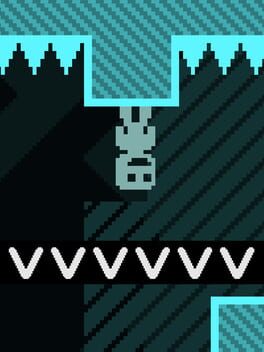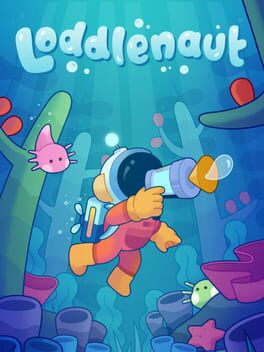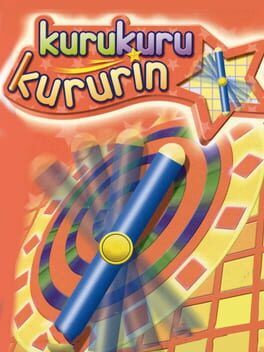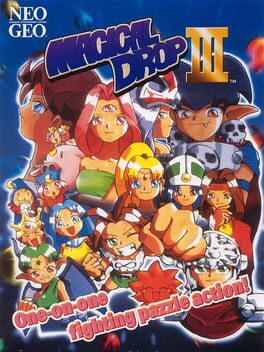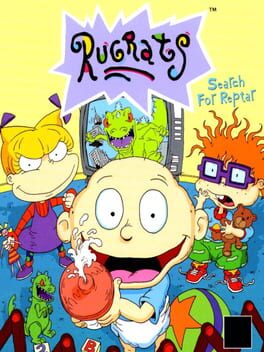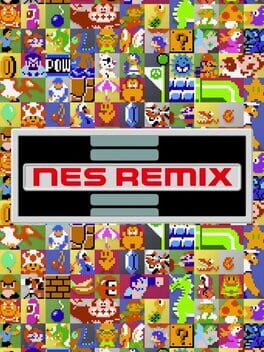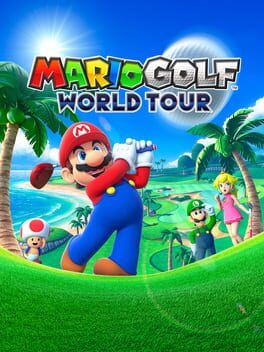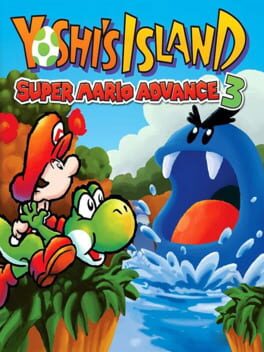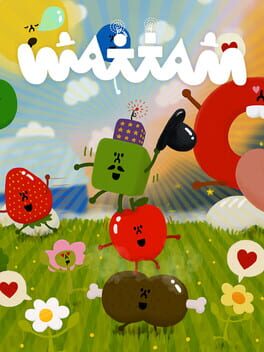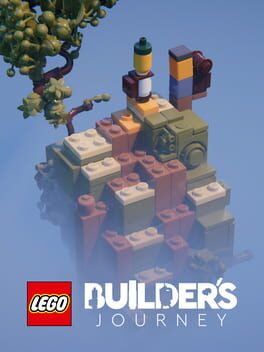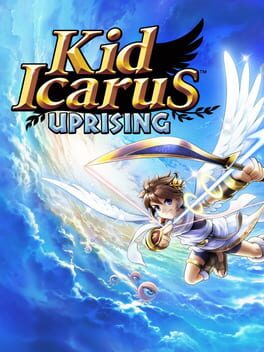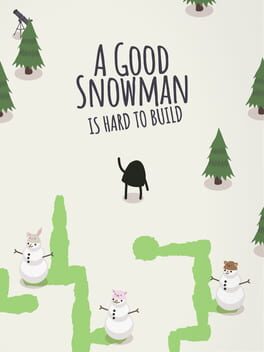GirambQuamb
2010
Been a while since I've played this one. A classic indie banger! Wonderfully crafted precision "platforming" with an interesting bunch of gimmicks that don't overstay their welcome.
The greatest praise I can give this game is how intuitive the mechanics all feel. Through both their simplicity and the environments in which they're taught, things like gravity-flipping, screen-wrapping, platform-disintegrating and more are all very easy to pick up.
My biggest complaint is that it's short. I can grind for time trials and Super Gravitron runs, but otherwise there's not too much else to do post-game aside from play it again. At least that's incentivized via death count related achievements.
Amazing soundtrack too!
The greatest praise I can give this game is how intuitive the mechanics all feel. Through both their simplicity and the environments in which they're taught, things like gravity-flipping, screen-wrapping, platform-disintegrating and more are all very easy to pick up.
My biggest complaint is that it's short. I can grind for time trials and Super Gravitron runs, but otherwise there's not too much else to do post-game aside from play it again. At least that's incentivized via death count related achievements.
Amazing soundtrack too!
2023
It's fine. Cute game with no real stakes. It's a long series of menial tasks, but not in a bad way. It's a game about cleaning and you clean.
Annoyances mostly boil down to inventory space and constant loss of boost, but I suppose less/quicker travel between areas would make this 4 hour game even shorter. Also takes some getting used to that you can't retreat from the direction you're cleaning whilst actually cleaning.
I don't really care for the loddles. They're cute, but I can't bring myself to care as much when there's mechanics like hunger attached to em. Makes them feel more like a Tamagotchi than a wild animal you can interact with.
I'd recommend it to anyone who wants to catch up on some podcasts while cleaning virtual space instead of their real living space.
Annoyances mostly boil down to inventory space and constant loss of boost, but I suppose less/quicker travel between areas would make this 4 hour game even shorter. Also takes some getting used to that you can't retreat from the direction you're cleaning whilst actually cleaning.
I don't really care for the loddles. They're cute, but I can't bring myself to care as much when there's mechanics like hunger attached to em. Makes them feel more like a Tamagotchi than a wild animal you can interact with.
I'd recommend it to anyone who wants to catch up on some podcasts while cleaning virtual space instead of their real living space.
2001
1997
Compared to other mediums, video games are harder to sell as members of the so bad it's good club. Something about the agency the player has over their own experience makes it hard to point and laugh at a game with serious flaws.
That being said, this is one of the funniest games I've ever played. A true growing pain in the shift to 3D models, Rugrats: Search for Reptar is clunky, annoying, and way too easy to beat in one sitting. But something about it... The repeating voice lines, the egregiously bad camera, the fact that bumping into a wall makes Tommy recoil - these things make it impossible not to laugh along as you play.
I would not seriously recommend this game, but I would absolutely recommend it in jest. It's all a matter of sharing my sense of humour.
That being said, this is one of the funniest games I've ever played. A true growing pain in the shift to 3D models, Rugrats: Search for Reptar is clunky, annoying, and way too easy to beat in one sitting. But something about it... The repeating voice lines, the egregiously bad camera, the fact that bumping into a wall makes Tommy recoil - these things make it impossible not to laugh along as you play.
I would not seriously recommend this game, but I would absolutely recommend it in jest. It's all a matter of sharing my sense of humour.
2013
Short review because I don't have the time to collect my thoughts.
This game rules! It's truly a best-of-both-worlds situation where Nintendo's retro catalogue meets something along the lines of Wario Ware or Rhythm Heaven. Games remain faithful to their source while still having some nice twists.
Was very impressed by the challenge it offered. Grabbing 3-stars on every challenge will likely go down as my gaming achievement of the year. Though that challenge does stem from some classic NES bullshit every once in a while. I'm looking at you Golf.
Overall this solidifies my opinion that NES games are best enjoyed through a modern lens. Gameplay can be timeless, but sometimes it needs to be repackaged to be palatable.
This game rules! It's truly a best-of-both-worlds situation where Nintendo's retro catalogue meets something along the lines of Wario Ware or Rhythm Heaven. Games remain faithful to their source while still having some nice twists.
Was very impressed by the challenge it offered. Grabbing 3-stars on every challenge will likely go down as my gaming achievement of the year. Though that challenge does stem from some classic NES bullshit every once in a while. I'm looking at you Golf.
Overall this solidifies my opinion that NES games are best enjoyed through a modern lens. Gameplay can be timeless, but sometimes it needs to be repackaged to be palatable.
Mario Golf: World Tour started as an on-a-whim download for listening to podcasts while I rot away. It served that purpose all the way to the surprisingly early credits roll, and will probably continue to serve that purpose for at least another few days.
It's good! I have no other frame of reference for Mario Golf games, but it fills that wonderful niche of being both relaxing to play and having a good amount of depth to the gameplay.
It's good! I have no other frame of reference for Mario Golf games, but it fills that wonderful niche of being both relaxing to play and having a good amount of depth to the gameplay.
2018
When I choose to play Minecraft I’m frequently jumpscared by from-behind arrows launched by cartoon skeletons. Hell, the first time I played Bioshock I was startled by the sound of a projector screen lowering - this was in the introductory segment, before any enemies had appeared. Even multiplayer shooters have my crosshair quivering in intense situations. All this is to say that first person games put me on high alert, let alone games with horror elements. I’ve still enjoyed my share of shooters, even balls-to-the-wall masochist games like Lovely Planet or Devil Daggers, but while DUSK is gracious enough to ask less of me mechanically, it demands much more of me emotionally.
Let’s be clear, I had a blast playing. While, for the sake of my sanity, I had to split each campaign into multiple play-sessions, those short bursts of bloodbath were nothing short of exhilarating. DUSK, with its low-fidelity look of horror and goosebump-inducing sound design, transmits carnage directly into the player's brain - electric guitar and all. Where I find my mind wandering, however, are the aspects of the game I’m certain to never experience.
DUSK has an awful lot going for it, but this is especially true for those who want to get the most out of their purchase. There’s multiple difficulty levels, secrets galore, and the end of each level - all of which can be replayed ad-nauseum once beaten in the campaign - has a plethora of stats for players to grind for. Whether you’re looking to get the fastest time on the hardest difficulty, explore every nook and cranny for secrets, or beat each level without killing a single enemy, there’s something there for everyone. Shockingly, this extends even to scaredy-cats like me.
I took levels slow and cautiously, leading enemies into corridors for easier pickings, and generally shying away from extra challenges so I could get to the end; a well earned breather after all the violence, I think. I did have my moments of catharsis - DUSK forces it upon you when it spawns swarms of enemies in large, open spaces. The point of the matter, however, is that I’ve barely scratched the surface of what this game has to offer, and my poor heart isn’t in it for the long haul. But while the feast offered to hardcore players is something I will happily admire from afar, I’m forced to assume they were handled with care. For all I’ve said about DUSK having it’s more ambitious of players in mind, it’s clear that the blood-lust was crafted for everyone. There’s accessibility options galore, the easiest difficulty is more than fair, and there’s even cheat codes reminiscent of classic games of the genre. Whether I’m getting the full experience or not, the fact that players like me were even thought of at all inspires confidence.
At its core, DUSK is a game of dread and deliverance. Playing on easy mode doesn’t save you from the game’s more petrifying moments, nor does it diminish the more euphoric moments of massacre. Horrors lurk around every corner, and god damn if the plan isn’t to shoot them with a shotgun until they die. The beauty in DUSK are the feelings it evokes regardless of playstyle. However difficult you choose to make that shot, and however many times you plan to take it, it’s guaranteed to make your heart race.
Let’s be clear, I had a blast playing. While, for the sake of my sanity, I had to split each campaign into multiple play-sessions, those short bursts of bloodbath were nothing short of exhilarating. DUSK, with its low-fidelity look of horror and goosebump-inducing sound design, transmits carnage directly into the player's brain - electric guitar and all. Where I find my mind wandering, however, are the aspects of the game I’m certain to never experience.
DUSK has an awful lot going for it, but this is especially true for those who want to get the most out of their purchase. There’s multiple difficulty levels, secrets galore, and the end of each level - all of which can be replayed ad-nauseum once beaten in the campaign - has a plethora of stats for players to grind for. Whether you’re looking to get the fastest time on the hardest difficulty, explore every nook and cranny for secrets, or beat each level without killing a single enemy, there’s something there for everyone. Shockingly, this extends even to scaredy-cats like me.
I took levels slow and cautiously, leading enemies into corridors for easier pickings, and generally shying away from extra challenges so I could get to the end; a well earned breather after all the violence, I think. I did have my moments of catharsis - DUSK forces it upon you when it spawns swarms of enemies in large, open spaces. The point of the matter, however, is that I’ve barely scratched the surface of what this game has to offer, and my poor heart isn’t in it for the long haul. But while the feast offered to hardcore players is something I will happily admire from afar, I’m forced to assume they were handled with care. For all I’ve said about DUSK having it’s more ambitious of players in mind, it’s clear that the blood-lust was crafted for everyone. There’s accessibility options galore, the easiest difficulty is more than fair, and there’s even cheat codes reminiscent of classic games of the genre. Whether I’m getting the full experience or not, the fact that players like me were even thought of at all inspires confidence.
At its core, DUSK is a game of dread and deliverance. Playing on easy mode doesn’t save you from the game’s more petrifying moments, nor does it diminish the more euphoric moments of massacre. Horrors lurk around every corner, and god damn if the plan isn’t to shoot them with a shotgun until they die. The beauty in DUSK are the feelings it evokes regardless of playstyle. However difficult you choose to make that shot, and however many times you plan to take it, it’s guaranteed to make your heart race.
A shining beacon in my ever fading memories of childhood, Yoshi’s Island reenters my adult life as a pastel coloured flashback. The game, boasting its vibrant, cheerful atmosphere, taps directly into blurred memories of car rides home from grandma’s. The joyful sounds of the Yoshis themselves forming songs which evoke late night gaming sessions lit only by a bedside lamp that ought to have been turned off hours ago if I wasn’t to be tired at school in the morning.
My grandmother’s house has since been demolished, and my childhood has since been replaced by an ever growing list of ambitions, obligations, and responsibilities. My Yoshi’s Island cartridge, in contrast, remains the same; it holds the same code needed to run on my Game Boy Advance, and the same save files created all those years ago. Still, even if Yoshi’s Island itself has not changed, the lens through which I’m meant to inspect it, tinted-by-nostalgia as it may be, has been altered by the passage of time.
Games enjoyed in childhood often fail to prove their worth again. Patience is worn thin by frustrating levels, design intentions are rendered moot by modern sensibilities, and on a more enigmatic level, they just don’t feel the same. When the curtain of childlike wonder is pulled back, and our analytical minds are no longer shielded from the experience of actually playing, it takes a hell of a good game to maintain its favour.
Despite this sentiment, Yoshi’s Island manages to both impress me in the modern era of gaming, as well as justify its ineffable worthiness forged by my nostalgia-fueled memories. Set forth by its stunning visuals and maintained by its meticulously crafted gameplay experience, Yoshi’s Island is more than a happy memory, and even more than a timeless classic. It’s one of gaming’s greatest.
Before even a save file has been selected, Yoshi’s Island presents the player with its charm in the form of a storybook-esque movie sequence. Filled with a mix of clay-like models and watercolour backgrounds, the story set forth is simple, the Yoshis must deliver a lost baby Mario to his captured brother and save him from the evil Kamek. What the game makes clear, however, is that the gameplay itself is not merely a result of this story, but a continuation of it.
It’s an obvious statement, asserting that a game’s story continues beyond the intro and into play, but it’s Yoshi’s Island thematic commitment to that notion that drives its charm. Gameplay maintains the watercolour palette, but with a gorgeous art style reminiscent of children’s book illustrations.
Through flowery fields and sparkly caves, tropical lakes and snowy mountains, everything the player sees is oozing childlike charm. Highlights are bright and shadows are faint. Everything smiles, with exceptions only for characters with no mouth or big goofy teeth. Animation is smooth and lively, eyes are dotted and googly, and even the angriest of characters are made to look silly. To be frowning while playing Yoshi’s Island is to be a curmudgeon.
This vibe of the game - its art direction and presentation, the sensory feel it provides - is practically begging to plant itself into a young mind. It’s a visual masterpiece. It’s bright, colourful, and cheery - emanating an aura that thrusts warm and fuzzy feelings upon the player. However, it’s in the more agentive and invisibly-designed aspects of Yoshi’s Island - the things you only notice during gameplay - that the game soars beyond childhood favourite and emerges as a gaming paragon.
Yoshi’s controls are as responsive as they are free. That is to say the myriad of actions the player can take feel natural and are performed with ease. With just the dpad, two face buttons, and two shoulder buttons (the left shoulder button seldom seeing use in my playthrough), the player can perform the following in regular play: Jumping, flutter jumping, sticking Yoshi’s tongue out, spitting out enemies, ground pounding, egg aiming, egg throwing, and stopping your aim reticle from its automatic repositioning.
Despite having so many unique actions - some of which are altered by dpad directions, or holding a button longer - everything works together in an exciting way that avoids overwhelming the player, while still allowing for advanced play. Yoshi’s tongue is used only if an enemy is not in his mouth, and flutter jumps are only performed if he is already in the air, but the ability to throw eggs is independent of both, allowing a skilled player to take aim in more perilous situations.
Level design compliments this freedom of control by means of freedom of directionality. Compared to Super Mario World, Yoshi’s Island manages fewer branching paths and secret exits, but more than makes up for it in its level layouts. Levels go beyond left-to-right; they go up, down, and all around, even within the same section of level. Yoshi flutters his way through vertical climbs, ricochets eggs through maze-like passageways, and even transforms into motorized vehicles to soar through skies and drive down hills.
This variety in obstacle layout does come to bite Yoshi’s Island every once in a while. There’s long pits that a mountain-skiing Yoshi is sure to fall into, and sections to be redone when you learn that lava is insta-kill. To top it off, players going for a perfect score each level are in for a far more intense experience. Collectibles are well hidden, or even lost when damage is taken. But to call these game-ruining would be insincere when that variegation is what makes Yoshi’s Island so special.
Boss fights in particular speak to this. They test the player’s skills in new and exciting ways, all while holding the most charming moments of the game. The world 3 boss in particular subverts expectations, when Kamek - normally one to transform regular enemies into big baddies - uses magic on Yoshi himself, shrinking him down and giving the player the wobbly playing field of Prince Froggy’s innards. It’s moments like these - where novel concepts become novel spectacles, and novel spectacles become novel interactions - that boost Yoshi’s Island into gaming stardom.
But lest I forget the small moments. From the short but catchy overworld music that adds instruments as you progress, to the real sense of urgency when you must rescue a crying baby Mario after taking damage, Yoshi’s Island does more than bridge the gap between my Mad Catz Game Boy Advance light and my newly installed backlit screen mod. It cements itself as a game I was lucky to have played so young, lucky to have played now, and will be lucky to play again.
It takes a hell of a game to prove its worthiness when it’s been fueled by over a decade of vague nostalgia, but as much as my life and the world surrounding it has changed, the only thing that’s changed about Yoshi’s Island is my appreciation for it. Like myself, it has only grown.
My grandmother’s house has since been demolished, and my childhood has since been replaced by an ever growing list of ambitions, obligations, and responsibilities. My Yoshi’s Island cartridge, in contrast, remains the same; it holds the same code needed to run on my Game Boy Advance, and the same save files created all those years ago. Still, even if Yoshi’s Island itself has not changed, the lens through which I’m meant to inspect it, tinted-by-nostalgia as it may be, has been altered by the passage of time.
Games enjoyed in childhood often fail to prove their worth again. Patience is worn thin by frustrating levels, design intentions are rendered moot by modern sensibilities, and on a more enigmatic level, they just don’t feel the same. When the curtain of childlike wonder is pulled back, and our analytical minds are no longer shielded from the experience of actually playing, it takes a hell of a good game to maintain its favour.
Despite this sentiment, Yoshi’s Island manages to both impress me in the modern era of gaming, as well as justify its ineffable worthiness forged by my nostalgia-fueled memories. Set forth by its stunning visuals and maintained by its meticulously crafted gameplay experience, Yoshi’s Island is more than a happy memory, and even more than a timeless classic. It’s one of gaming’s greatest.
Before even a save file has been selected, Yoshi’s Island presents the player with its charm in the form of a storybook-esque movie sequence. Filled with a mix of clay-like models and watercolour backgrounds, the story set forth is simple, the Yoshis must deliver a lost baby Mario to his captured brother and save him from the evil Kamek. What the game makes clear, however, is that the gameplay itself is not merely a result of this story, but a continuation of it.
It’s an obvious statement, asserting that a game’s story continues beyond the intro and into play, but it’s Yoshi’s Island thematic commitment to that notion that drives its charm. Gameplay maintains the watercolour palette, but with a gorgeous art style reminiscent of children’s book illustrations.
Through flowery fields and sparkly caves, tropical lakes and snowy mountains, everything the player sees is oozing childlike charm. Highlights are bright and shadows are faint. Everything smiles, with exceptions only for characters with no mouth or big goofy teeth. Animation is smooth and lively, eyes are dotted and googly, and even the angriest of characters are made to look silly. To be frowning while playing Yoshi’s Island is to be a curmudgeon.
This vibe of the game - its art direction and presentation, the sensory feel it provides - is practically begging to plant itself into a young mind. It’s a visual masterpiece. It’s bright, colourful, and cheery - emanating an aura that thrusts warm and fuzzy feelings upon the player. However, it’s in the more agentive and invisibly-designed aspects of Yoshi’s Island - the things you only notice during gameplay - that the game soars beyond childhood favourite and emerges as a gaming paragon.
Yoshi’s controls are as responsive as they are free. That is to say the myriad of actions the player can take feel natural and are performed with ease. With just the dpad, two face buttons, and two shoulder buttons (the left shoulder button seldom seeing use in my playthrough), the player can perform the following in regular play: Jumping, flutter jumping, sticking Yoshi’s tongue out, spitting out enemies, ground pounding, egg aiming, egg throwing, and stopping your aim reticle from its automatic repositioning.
Despite having so many unique actions - some of which are altered by dpad directions, or holding a button longer - everything works together in an exciting way that avoids overwhelming the player, while still allowing for advanced play. Yoshi’s tongue is used only if an enemy is not in his mouth, and flutter jumps are only performed if he is already in the air, but the ability to throw eggs is independent of both, allowing a skilled player to take aim in more perilous situations.
Level design compliments this freedom of control by means of freedom of directionality. Compared to Super Mario World, Yoshi’s Island manages fewer branching paths and secret exits, but more than makes up for it in its level layouts. Levels go beyond left-to-right; they go up, down, and all around, even within the same section of level. Yoshi flutters his way through vertical climbs, ricochets eggs through maze-like passageways, and even transforms into motorized vehicles to soar through skies and drive down hills.
This variety in obstacle layout does come to bite Yoshi’s Island every once in a while. There’s long pits that a mountain-skiing Yoshi is sure to fall into, and sections to be redone when you learn that lava is insta-kill. To top it off, players going for a perfect score each level are in for a far more intense experience. Collectibles are well hidden, or even lost when damage is taken. But to call these game-ruining would be insincere when that variegation is what makes Yoshi’s Island so special.
Boss fights in particular speak to this. They test the player’s skills in new and exciting ways, all while holding the most charming moments of the game. The world 3 boss in particular subverts expectations, when Kamek - normally one to transform regular enemies into big baddies - uses magic on Yoshi himself, shrinking him down and giving the player the wobbly playing field of Prince Froggy’s innards. It’s moments like these - where novel concepts become novel spectacles, and novel spectacles become novel interactions - that boost Yoshi’s Island into gaming stardom.
But lest I forget the small moments. From the short but catchy overworld music that adds instruments as you progress, to the real sense of urgency when you must rescue a crying baby Mario after taking damage, Yoshi’s Island does more than bridge the gap between my Mad Catz Game Boy Advance light and my newly installed backlit screen mod. It cements itself as a game I was lucky to have played so young, lucky to have played now, and will be lucky to play again.
It takes a hell of a game to prove its worthiness when it’s been fueled by over a decade of vague nostalgia, but as much as my life and the world surrounding it has changed, the only thing that’s changed about Yoshi’s Island is my appreciation for it. Like myself, it has only grown.
2019
"The little brand people made me cry" - Some self-proclaimed Disney Adult, probably.
Glad I got this game for free; it's not worth my money. I thought we'd already perfected placing blocks on a grid, but the way this game controls says otherwise.
It's a bunch of slow puzzles with little room for actual puzzle-solving. Fine for a narrative game - and I can respect what they were going for in that department - but the story reads to me as a little up its own ass. Any bit of narrative was drowned out by the frustration of trying to place a block without picking it back up again anyways. I can't stress enough how godawful the controls are.
Glad I got this game for free; it's not worth my money. I thought we'd already perfected placing blocks on a grid, but the way this game controls says otherwise.
It's a bunch of slow puzzles with little room for actual puzzle-solving. Fine for a narrative game - and I can respect what they were going for in that department - but the story reads to me as a little up its own ass. Any bit of narrative was drowned out by the frustration of trying to place a block without picking it back up again anyways. I can't stress enough how godawful the controls are.
2012
While it's very difficult to cope with the controls at first - namely in land battles - this game is worth the initial struggles. One of the very best the 3DS has to offer, and almost certainly the best action game.
It's oozing with charm, the gameplay manages to have a good amount of depth without bogging down the pacing, and gosh darn it it's just fun. I cracked many a smile during my playthrough.
It's oozing with charm, the gameplay manages to have a good amount of depth without bogging down the pacing, and gosh darn it it's just fun. I cracked many a smile during my playthrough.
Fine game! Looks absolutely beautiful, even on the tiny screen of the original 3DS. Very easy, but that's kinda what they were going for here so it's hard to critique it on that. Especially with how many collectables there are and the hard mode option for each level.
Kinda rushed through it, which made for quite the short experience, but there's extra levels and plenty of side content waiting for me if I decide to go back.
Kinda rushed through it, which made for quite the short experience, but there's extra levels and plenty of side content waiting for me if I decide to go back.
